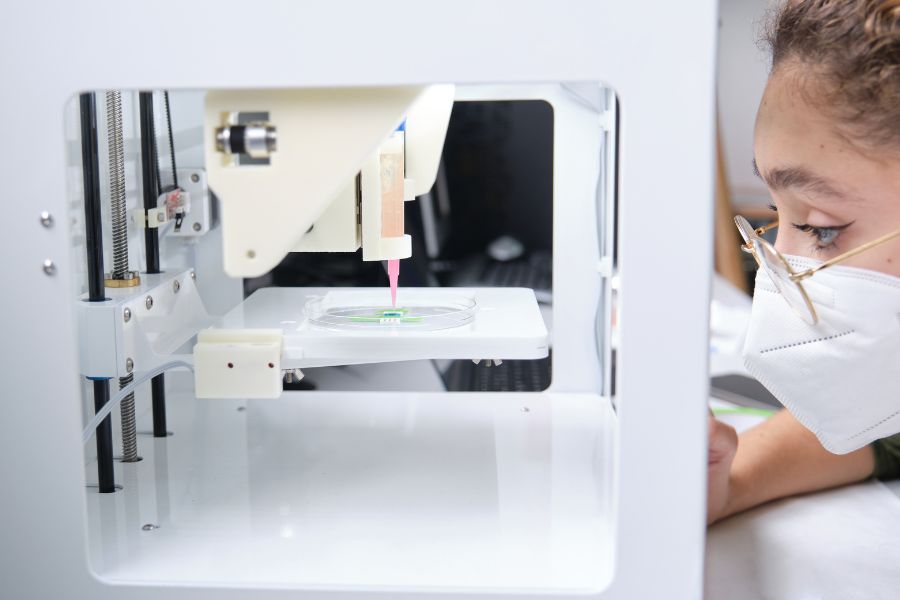Sat - Thu
8:00 AM - 6: 00 PM

Tissue Engineering represents a revolutionary frontier in medical science, aiming to restore, maintain, or improve the function of damaged biological tissues. It's a highly interdisciplinary field that strategically combines principles from engineering, biology, and medicine to create functional constructs that can repair, replace, or enhance diseased or injured tissues in the body. Unlike traditional treatments that might only manage symptoms or replace lost function with artificial implants, tissue engineering strives for genuine biological integration and regeneration. At AdvanCell, we are at the forefront of translating the intricate science of Tissue Engineering into tangible clinical solutions. Our approach focuses on leveraging cutting-edge methodologies to foster the body's intrinsic healing capabilities, offering new hope for conditions characterized by significant tissue loss or degeneration. Tissue engineering fundamentally relies on the interplay of three key components: Cells: These are the building blocks of new tissue. They can be sourced from the patient's own body (autologous cells) or from carefully screened donors (allogeneic cells). The selection and preparation of specific cell types, such as mesenchymal stem cells (MSCs) or chondrocytes, are critical for directing tissue formation. Scaffolds: These are biocompatible, three-dimensional structures that serve as temporary templates or frameworks for cell growth and tissue formation. Scaffolds provide structural support, guide cell organization, and create a conducive microenvironment for tissue development. They can be made from natural polymers (e.g., collagen, fibrin) or synthetic materials (e.g., biodegradable plastics). Signaling Molecules (Growth Factors & Bioreactors): These are biological cues that influence cellular behavior, promoting cell proliferation, differentiation, and tissue maturation. Growth factors, often delivered through methods like Platelet-Rich Plasma (PRP) or contained within Stromal Vascular Fraction (SVF) and Bone Marrow Concentrate (BMC), provide the necessary instructions. In some advanced applications, bioreactors are used to provide precise physical and biochemical stimuli to guide tissue development in vitro before implantation. AdvanCell integrates the principles of tissue engineering within our broader Regenerative Medicine framework to develop personalized and effective treatment strategies. Our focus areas include: Cell-Based Therapies: Utilizing isolated or concentrated cells (like MSCs from adipose tissue or bone marrow) to directly populate a damaged area, fostering regeneration. Biomaterial-Enhanced Regeneration: Employing biocompatible scaffolds, often laden with cells or growth factors, to provide structural support and guide tissue repair in situ. Strategic Biologic Augmentation: Combining cellular therapies with rich sources of growth factors like Platelet-Rich Plasma (PRP) or Stromal Vascular Fraction (SVF) to optimize the regenerative microenvironment. The transformative potential of Tissue Engineering is vast, offering solutions for complex medical challenges where conventional treatments fall short. At AdvanCell, we focus on applications that aim for true tissue repair and regeneration: Cartilage Regeneration: Addressing degenerative joint conditions like osteoarthritis and focal cartilage defects. Tissue engineering offers pathways for chondrogenesis (new cartilage formation) to restore joint surface integrity and reduce pain. Bone Repair & Regeneration: For non-union fractures, large bone defects, or conditions requiring bone augmentation, engineered bone constructs or targeted cellular therapies can accelerate osteogenesis (bone growth) and improve structural stability. Soft Tissue Reconstruction: In cases of chronic tendon and ligament injuries, tissue engineering principles guide strategies to strengthen and regenerate damaged connective tissues, promoting tenogenesis and improving mechanical resilience. Wound Healing & Skin Regeneration: For complex, non-healing chronic wounds or significant burns, tissue-engineered skin substitutes or cellular therapies can accelerate wound closure, promote re-epithelialization, and improve the quality of regenerated skin. Nerve Regeneration: While still an evolving field, early applications explore guiding neurogenesis and axonal regrowth in peripheral nerve injuries, enhancing functional recovery. AdvanCell is dedicated to advancing healthcare through scientifically rigorous and ethically sound applications of Tissue Engineering. Our commitment is underpinned by: Interdisciplinary Expertise: A collaborative team of qualified medical doctors, scientists, and specialized physiotherapists. Advanced Techniques: Utilizing state-of-the-art procedures for cell isolation, preparation, and precise delivery. Evidence-Based Protocols: Adhering to the latest scientific research and clinical guidelines to ensure safe and effective outcomes. Patient-Centric Solutions: Developing personalized treatment plans that integrate tissue engineering principles with holistic rehabilitative care.Tissue Engineering: Building the Future of Regenerative Medicine at AdvanCell
The Core Principles of Tissue Engineering
AdvanCell's Approach to Tissue Engineering
Clinical Applications of Tissue Engineering at AdvanCell
Why Choose AdvanCell for Tissue Engineering?
By leveraging the power of Tissue Engineering, AdvanCell is not just treating symptoms; we're actively participating in building a healthier future, one regenerated tissue at a time.